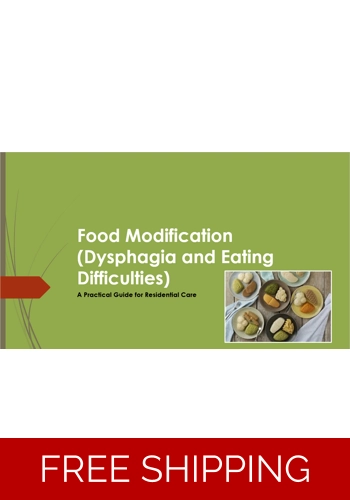Food Modification (Dysphagia/Eating Difficulties)-A Practical Guide for Residential Care
Food Modification (Dysphagia and Eating Difficulties) - A Practical Guide for Residential Care Health ad Social Care Teaching/Training Resources
All fully editable.
Presentation in sections you can choose which sections to use. Aims and Objectives included if you want to use the presentation as it has been written. Comes with a 26 Page Master Handout, 8 Handouts of the Sections covered and a Multiple Choice End of Session Assessment.
Aims and Objectives:
- Overall Aim: To enhance awareness and provide practical knowledge for Residential Care and Kitchen Staff on food preparation and design for individuals with swallowing difficulties.
Learning Objectives:
- Understand the challenges faced by individuals with swallowing difficulties in food consumption.
- Identify appropriate food adaptations and design considerations for individuals with swallowing difficulties.
- Learn techniques and strategies for food preparation tailored to individuals with swallowing difficulties.
- Demonstrate proficiency in implementing food adaptation techniques in a residential care setting
Presentation (91 Slides)
Aims and Objectives
Introduction
SECTION - Introduction to Swallowing Difficulties in Care Settings
Overview of Swallowing Difficulties: Causes and Implications
Importance of Addressing Swallowing Difficulties in Residential Care
Impact on Quality of Life and Nutritional Health of Residents
Collaborative Approach: Kitchen and Care Staff Partnership for Effective Support
SECTION - Understanding Swallowing Difficulties: Causes and Implications
Understanding Swallowing Difficulties: Causes and Implications
Neurological Conditions
Structural Abnormalities
Age-Related Changes
Medical Treatments
Degenerative Conditions and Psychological Factors
Implications- Reinforcing Learning
SECTION - Importance of Food Adaptation and Design
Dignity and Independence
Social Engagement
Nutritional Optimisation
Individualised Care
Prevention of Complications
Regulatory Compliance
End Comments
SECTION - Food Texture Modifications for Swallowing Difficulties
Introduction
Soft Diet
Soft Diet Considerations
Pureed Diet
Pureed Diet Considerations
Minced and Moist Diet
Minced and Moist Diet Considerations
Liquidised Diet
Liquidised Diet Considerations
SECTION - Considerations
Introduction
Nutritional Adequacy
Flavour, Colour and Presentation
Meal Appeal and Satisfaction
SECTION - Designing Nutritious and Palatable Meals
Balancing Nutritional Needs with Texture Modification
Importance of Understanding Individual Health or Medical Conditions
Tips for Enhancing Flavour and
Presentation - Flavour Enhancement
Tips for Enhancing Flavour and
Presentation – Presentation Enhancement
End Comments
SECTION - Ensuring Safety and Hygiene
Introduction
Cleanliness and Sanitation
Proper Food Handling
Texture Modification Techniques
Allergen Management
Monitoring and Documentation
Staff Training and Education
SECTION - Texture Modification Techniques
Pureed Diet
Minced and Moist Diet
Soft Diet
Liquidised Diet
Soft and Bite-Sized Diet
SECTION - Food Moulds and Shaping Techniques
Introduction
Types of Food Moulds
Shaping Techniques
Decorating and Garnishing
Advanced Techniques
Customisation
Ideas - Images
SECTION - Summary of Key Points
Key Points
References and Further Reading
Word Documents
1 Master Handout
8 Section Handouts
1 End of Session Assessment
HSC Training Link
Training Resources for Health and Social Care
Supplying training resources for the health and social care
sector since 2004.
Resources purchased are emailed to you via
Zip Folder attachment.
All packs are written in a generic style and can easily
be adapted to suit your own specific training delivery.
Resources are Word and PowerPoint based.
Secure payments via PayPal Merchant Commerce Platform.
You do not need a PayPal account to use this payment
gateway.
Debit and credit card payments accepted.





